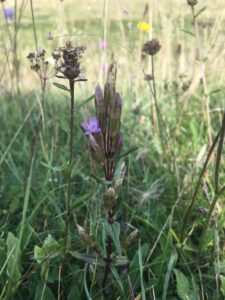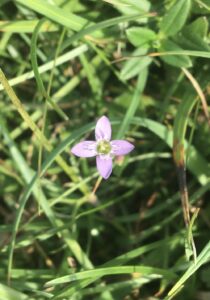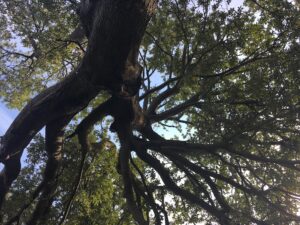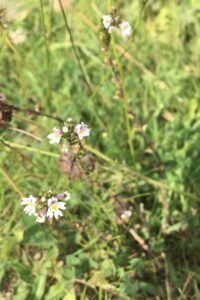In 2023, at Warham Camp, Emily Hasler laid with the eyebrights and the gentians.

At Warham Camp: my first eyebright. Tiny distinct flowers I know immediately — but even sharper and more delicate than expected. Glowing white with a perfect smudge of yellow and dark purple lashes; a hooded dress with pleated skirt. I drop to my knees. Hello! The word leaps into and out of my mouth: Eyebright!
*
Three months later: pressure around my eye sockets, as if I had my goggles on too tight. I think how much of this year has been seen through the goggles of pain, and how little I’ve been able to use my goggles.
*
At Warham Camp, an Iron Age fort in North Norfolk. September heatwave, my first Autumn gentians in unautumnal heat. Here they reach nowhere near their potential 30cm and, past their peak, they require searching. The shape of the plant, the positioning of the leaves and flowers on the stalk, is very like the its candy pink cousins, the centauries I see often at home. Of the cramped candelabra of buds only one or two are ‘open’ — only when it’s worth the effort do the tube shaped flowers spread their lobes (not petals) to reveal a pale-fringed recess at the centre. They can have four or five lobes-not-petals, but these all seem to have four: crisp and at right angles like a compass.

*
Two weeks later, eyes closed, curtains pulled. I’m in bed with a delayed flare-up from so much effort — and enjoyment. My friend Miranda gives me a word given to her: oncost. But that I had calculated this does not make it any easier to pay. I cannot read, cannot listen to a podcast. I miss learning even more than writing. Any effort — mental, emotional, physical — is dangerous. And my brain doesn’t work like it should. The connections don’t connect. The sparks don’t spark. Trying doesn’t help.
*
At Warham Camp — not far from the B&B; a bus ride and a short walk, which is a great effort. Covering 5.1 hectares, the fort has a diameter of 212 metres, but it is immense. We enter the gate from the hedged lane. The ramparts are vibrating purple with Devil’s-bit scabious. Up close Common rock-rose is a yellow that flickers between bright and mellow and Dwarf thistles burst without warning from the ground. The fort that remains is made of two large mounded ring shapes, now lopsided, one inside the other and a gap, a break, at each quarter. The two concentric walls are gently terraced, so that these large, built rings of earth have their own ripples, and those are not even but are subject to their own eccentricities and disturbances. The surface area increases the closer you get, creases, loosens. History and geology pucker it too. I will never take it all in, but I can be within it.
*
Immediately after I want to make a list, a catalogue. I want to harvest everything I can from the experience and make it writing. But I don’t find the time or energy. I look through the photos that my girlfriend, with her greater steadiness and patience, took of the plants we found. I do not share these photos on social media as I would usually. I keep them for myself, hidden, unspoken, not yet written of.
*
At Warham Camp the flora is mostly new to me. Specialist species growing in this outcrop of grass chalkland — a habitat that is unusual for the area and quite unlike the well-trodden clays of home. The heat and the volume of unfamiliar plants are overwhelming. Names detach from static images in wildflower books. I set up my own camp, lying on a swimming towel under the only shade: the Holly oak that grows within (but not at the centre of) the fort.
*
At Warham Camp the first eyebright is quickly joined by many more. The pointed beauty of the flower feels like a warning. I try to focus on the nettle-like leaves, grading from green to red at the serrated edges: they look almost herbal, good for a tea or a tincture — but are these leaves or the empty leaf-like sepals of previous flowers? I know this plant to be a parasite. I know this plant to be prone to hybridise and extremely difficult to identify to a species level. Euphrasia agg. says Collins, forbiddingly, you can’t be sure… Finding it here is enough.
*
Sometimes it’s not so bad: I manage myself well enough to manage a few hours work. I get out for a short walk to see what is growing, what has gone over. I am being taught patience. Before, my frequent tiredness meant I did things fast when I could do them. Now constant tiredness means there is only slow, stop, wait, again. So wildflowers suit me. When I can’t cover much ground; when my binoculars are too heavy on my neck, or I can’t hold them up to my eyes. Which is not to say I have not run towards plants as if they will escape, as if this longed for moment cannot be delayed another second. When I saw my first broomrape I clambered down the seawall and threw myself on the ground next to it, later discovering I’d sat directly on a dogshit.
*
At Warham Camp the heat hazes everything. Hours are gone. Sensations flood in and out of me: the masses of firsts, the Blue tit I watch from beneath the Holly oak tree.

*
At Warham Camp my back hurts and my head aches. The Chalkhill blue butterflies will not stay still. I place the heavy wildflower guide on the ground and drink more water. I work my way around, one quarter of each ring at a time, returning to the shelter of the Holly oak.
*
These days I am slower by nature and slower in nature. Need and desire seem to run parallel. I slowed down and saw there were plants; I looked for plants and it slowed me down. I need to lie down, that way I can get a closer look. My interest masks my limitations; my limitations give the excuse to my interests. As if the map and the photo were shown to almost align.
*
I’ve recently read several good books about plants. At least two are set around the idea of a quest over the course of a calendar year. It makes thematic sense, adds a narrative drive, plays to the market — but it frustrates me, as much as I genuinely enjoy the writing. I can’t imagine such mobility or certainty. As my body rejects this timeline, my mind rejects it — or any timeline. Flowers too seem to have a flagrant disregard for narrative, blooming whenever and wherever they can, finding little niches away from the wind or frost to bear out their own seasons. Turning up one year and not the next. Hello! I am always saying, a greeting and an enquiry. A Sea aster without its ray florets; Tormentil which I think of as low and tangled living out its Latin name of ‘erecta’ given the right conditions.
*
At Warham Camp time is deep and we can rest in its folds. Here is a fort. Here is a refuge: for plants, insects, people. A place for protection and a protected place. Despite the vertigo of the history, the geology, the botany, it is now. An Autumn gentian, and another one. And here, another one. Now this and always that. Imperative and endless. I return repeatedly to the shade of the Holly oak tree.
*
Later that day we missed the bus and a kind couple offered us a lift. I plan so much to make up for myself, but often I rely on kindness.
*
Three months later and this is the only thing I’ve written this year. I had been keeping a mental posy of the gentians and eyebrights (which I discover often grow together), hoping to write about them, afraid they might wilt. I have learnt about myself, my body. I have learnt to sometimes even apply those lessons. I have realised I cannot simply sit down and write, but need to feel a shape I can navigate, exit and return to. And perhaps it’s always been this way.
*
At Warham Camp. It’s something I say to myself. I’m at Warham Camp, with the eyebrights, the gentians. I imagine it balder, the flowers mostly over. I imagine returning earlier for the orchids.

***
Emily Hasler lives on the Suffolk-Essex border beside the River Stour. She has ME. She writes (when she has energy, which isn’t often) and swims all year round (except when she’s ill, which is much of the year). A few years ago she decided she should get to know wildflowers. Her latest collection of poems is ‘Local Interest’ (Pavilion Poetry, 2023).